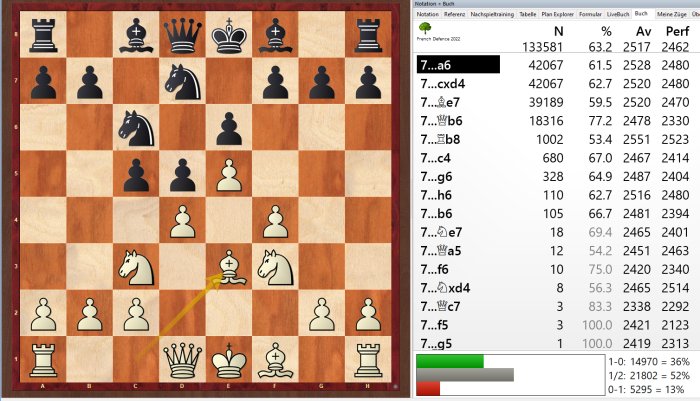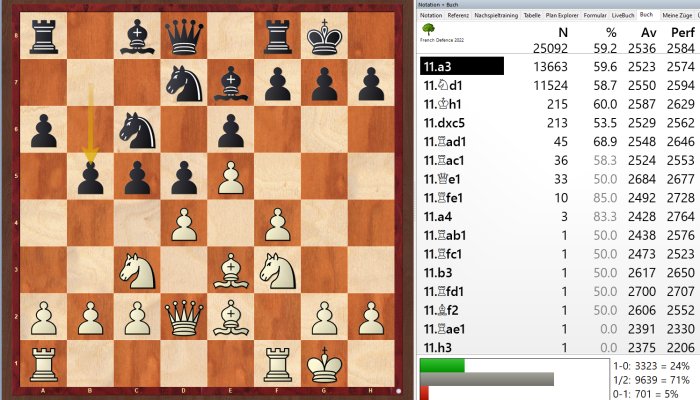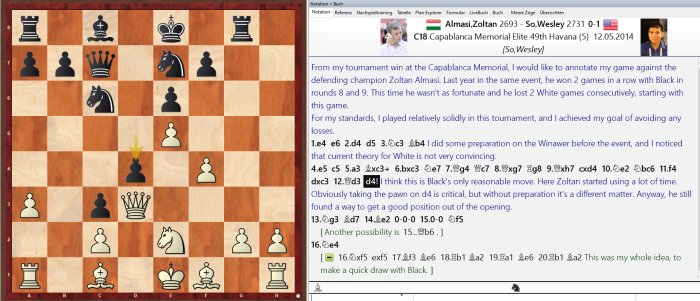- Sie haben noch keine Artikel in Ihrem Warenkorb.






ChessBase Fritztrainer Eröffnung, Englisch, 2022.
Niveau: Fortgeschrittenen, Turnierspieler, Profi
The French Defence is one of the most popular openings - from club player to grandmaster. It’s a very solid opening against 1.e4 but leaves room for counterplay and initiative. In this two-volume video course former world-champion and startrainer Rustam Kasimdzhanov shows you the ins and outs of this hugely complex opening. Through his vast experience both as a player, as well as the second of Vishy Anand and Fabiano Caruana; Kasimdzhanov has created a full lifetime repertoire after 1.e4 e6 for you. Start your journey now!
Volume 1 - The Classical Variation 3.Nc3 Nf6 (ISBN: 978-3-86681-842-2)
3.Nc3 Nf6 4.e5
3.Nc3 Nf6 4.Bg5
3.Nc3 Nf6 Sidelines
- Video running time: 5 hours (English)
- With interactive training including video Feedback
- Extra: Training with ChessBase apps - Memorize the opening repertoire and play key positions against Fritz on various levels
Volume 2 - 3.Nd2, 3.e5, 3.exd5 & Sidelines (ISBN: 978-3-86681-843-9)
3.Nd2 c5
3.e5 c5
3.exd5 exd5
Sidelines
- Video running time: 5 hours 45 minutes (English)
- With interactive training including video Feedback
- Extra: Training with ChessBase apps - Memorize the opening repertoire and play key positions against Fritz on various levels
French Defence Powerbase 2022
The 659 selected annotated games offer excellent study materials. Top players such as Carlsen (2 annotated games), Caruana (5), Anand (4), So (2), Radjabov (2), Nepomniachtchi (1), Karjakin (1), Harikrishna (1), Navara (1), Vitiugov (2) analysed their games, plus French experts like Marin (46), Edouard (31), Sadorra (28), Atalik (23) and Berg (23). All in all, there are 10.275 such games and they do have a rating-average of at least 2580 (except games with annotations and those of French experts).
A double click on the database loads the games overview. A further double click loads the relevant game. The tab Players lets you sort the games according to frequency (with the tab Total). This helps to take a closer look at games from players such as Shirov (an expert for White) or Meier, Kortschnoj and Volkov.
The games can be played through or further investigated with an engine or a Powerbook.
French Defence Powerbook 2022
For the French Powerbook top-quality material was used: 870,000 games from the Mega and from correspondence chess, plus 655,000 games from the playchess.com engine room. The statistics in the Winawer, particularly in the sharp line 7.Qg4 Qc7, are hardly appealing for Black, and they help to understand why the top players use this set-up only very rarely. In huge contrast to the Steinitz Variation 3.Nc3 Nf6. E.g. the line 4.e5 Nfd7 5.f4 c5 6.Nf3 Nc6 7.Be3 which currently is the most popular continuation for both sides

Here 7...cxd4 is still the most popular move but there is a trend to play 7...Be7 and particularly 7...a6 – which is already the most often played move in the online database.
In the Steinitz Variation White has only a few promising alternatives but Black has a number of good options to deviate. For instance with 7...a6 8.Qd2 Be7 9.Be2 b5 10.0-0 0-0.

The statistics in the Powerbook for this line are based on almost 24,000 games while the online database has little more than a 1,000 games with this Variation.
Großmeister Rustam Kasimdzhanov, 1979 geboren in Usbekistan, ist seit vielen Jahren als bärenstarker und einfallsreicher Spieler bekannt. Doch im Jahr 2004 verblüffte Rustam Kasimdzhanov die Schachwelt, als er den Titel des FIDE-Weltmeisters eroberte und dabei eine ganze Reihe von Weltklassespielern wie Ivanchuk, Grischuk, Topalov und Adams ausschaltete. Der Usbeke, der Anand bei seinen beiden Weltmeisterschaftskämpfen sekundierte, lebt in Deutschland.
Volume 1
Introduction
Model Game 1: Karjakin-Morozevich
Model Game 2: Aronian-Bluebaum
Model Game 3: Movsesian-Meier
Analysis Database
1.e4 e6 2.d4 d5 3.Nc3 Nf6 4.e5
1.e4 e6 2.d4 d5 3.Nc3 Nf6
4.e5 Nfd7 5.Nce2 c5 6.c3 Nc6 without f4
4.e5 Nfd7 5.Nce2 c5 6.c3 Nc6 7.f4 Be7 8.Nf3 0-0 9.h4/g3/a3
4.e5 Nfd7 5.Nce2 c5 6.c3 Nc6 7.f4 Be7 8.Nf3 0-0 9.Be3
4.e5 Nfd7 5.Nf3
4.e5 Nfd7 5.f4 c5 6.Nf3 Nc6 7.Be3 cxd4 8.Nxd4 Qb6 Intro
4.e5 Nfd7 5.f4 c5 6.Nf3 Nc6 7.Be3 cxd4 8.Nxd4 Qb6 Sidelines
4.e5 Nfd7 5.f4 c5 6.Nf3 Nc6 7.Be3 cxd4 8.Nxd4 Qb6 9.Qd2 Qxb2 10.Rb1 Qa3 11.Ncb5 Qxa2 12.Rb3
4.e5 Nfd7 5.f4 c5 6.Nf3 Nc6 7.Be3 cxd4 8.Nxd4 Qb6 9.Qd2 Qxb2 10.Rb1 Qa3 11.Ncb5 Qxa2 12.Rd1/Rc1
4.e5 Nfd7 5.f4 c5 6.Nf3 Nc6 7.Be3 cxd4 8.Nxd4 Qb6 9.Qd2 Qxb2 10.Rb1 Qa3 11.Bb5 Nxd4 12.Bxd4 a6 early deviations
4.e5 Nfd7 5.f4 c5 6.Nf3 Nc6 7.Be3 cxd4 8.Nxd4 Qb6 9.Qd2 Qxb2 10.Rb1 Qa3 11.Bb5 Nxd4 12.Bxd4 a6 13.Bxd7 Bxd7 14.Rxb7
4.e5 Nfd7 5.f4 c5 6.Nf3 Nc6 7.Be3 cxd4 8.Nxd4 Qb6 9.Qd2 Qxb2 10.Rb1 Qa3 11.Bb5 Nxd4 12.Bxd4 a6 13.Bxd7 Bxd7 14.Rb3 Qe7 15.0-0
4.e5 Nfd7 5.f4 c5 6.Nf3 Nc6 7.Be3 cxd4 8.Nxd4 Qb6 9.Qd2 Qxb2 10.Rb1 Qa3 11.Bb5 Nxd4 12.Bxd4 a6 13.Bxd7 Bxd7 14.Rb3 Qe7 15.Rxb7 Rc8
4.e5 Nfd7 5.f4 c5 6.Nf3 Nc6 7.Be3 cxd4 8.Nxd4 Qb6 9.Qd2 Qxb2 10.Rb1 Qa3 11.Bb5 Nxd4 12.Bxd4 a6 13.Bxd7 Bxd7 14.Rb3 Qe7 15.Rxb7 Qd8
4.e5 Nfd7 5.f4 c5 6.Nf3 Nc6 7.Be3 cxd4 8.Nxd4 Qb6 9.Qd2 Qxb2 10.Rb1 Qa3 11.Bb5 Nxd4 12.Bxd4 a6 13.Bxd7 Bxd7 14.Rb3 Qe7 15.Rxb7 Qh4 16.g3/Bf2
4.e5 Nfd7 5.f4 c5 6.Nf3 Nc6 7.Be3 cxd4 8.Nxd4 Qb6 9.Qd2 Qxb2 10.Rb1 Qa3 11.Bb5 Nxd4 12.Bxd4 a6 13.Bxd7 Bxd7 14.Rb3 Qe7 15.Rxb7 Qh4 16.Qf2
1.e4 e6 2.d4 d5 3.Nc3 Nf6 4.Bg5
4...h6 4...dxe4 5.Nxe4 Be7 6.Nxf6 Bxf6 7.Bxf6 Qxf6 8.Nf3 c5
4...dxe4 5.Nxe4 Be7 6.Nxf6 Bxf6 7.Bxf6 Qxf6 8.Nf3 0-0 9.Qd3 c5 and Sidelines
4...dxe4 5.Nxe4 Be7 6.Nxf6 Bxf6 7.Bxf6 Qxf6 8.Nf3 0-0 9.Qd3 Rd8
4...dxe4 5.Nxe4 Be7 6.Bxf6 gxf6 7.g3/Qd2
4...dxe4 5.Nxe4 Be7 6.Bxf6 gxf6 7.Nc3
4...dxe4 5.Nxe4 Be7 6.Bxf6 gxf6 7.Nf3 a6 8.c4
4...dxe4 5.Nxe4 Be7 6.Bxf6 gxf6 7.Nf3 a6 8.Bd3/Qd2
4...dxe4 5.Nxe4 Be7 6.Bxf6 gxf6 7.Nf3 a6 8.Qe2 f5 9.Nc3 b5 10.Qe3/g3
4...dxe4 5.Nxe4 Be7 6.Bxf6 gxf6 7.Nf3 a6 8.Qe2 f5 9.Nc3 b5 10.0-0-0
4...dxe4 5.Nxe4 Be7 6.Bxf6 gxf6 7.Nf3 a6 8.g3 Nc6/b5
4...dxe4 5.Nxe4 Be7 6.Bxf6 gxf6 7.Nf3 a6 8.g3 f5
1.e4 e6 2.d4 d5 3.Nc3 Nf6 Sidelines
4.exd5 exd5
4.Bd3 c5
Outro
Exercises
Description
Exercise 1 - 17
Volume 2
Introduction
Model Game 1: Kasparov-Anand
Model Game 2: Shabalov-Shirov
1.e4 e6 2.d4 d5 3.e5
1.e4 e6 2.d4 d5 3.e5 c5 4.c3 Nc6 5.Nf3 Qb6
Early sidelines
6.Na3 Bd7
6.Bd3 cxd4 7.0-0 Bd7
6.Bd3 cxd4 7.cxd4 Bd7
6.a3 Nh6 7.b4 Sidelines
6.a3 Nh6 7.b4 cxd4 8.Bxh6 gxh6 9.cxd4 Bd7 10.Ra2
6.a3 Nh6 7.b4 cxd4 8.cxd4
6.a3 Nh6 7.Bd3
6.Be2 cxd4 7.cxd4 Nh6 Sidelines
6.Be2 cxd4 7.cxd4 Nh6 8.Bxh6 Qxb2 9.Nbd2 gxh6 10.0-0 Bd7 11.Rb1 Qxa2
6.Be2 cxd4 7.cxd4 Nh6 8.Bxh6 Qxb2 9.Nbd2 gxh6 10.0-0 Bd7 11.a4/Nb3
1.e4 e6 2.d4 d5 3.Nd2
1.e4 e6 2.d4 d5 3.Nd2 c5
Rare lines
4.exd5 Qxd5 5.Ngf3 cxd4 6.Bc4 Qd6 7.Ne4 and 7.0-0 Nf6 8.Nb3 Nc6 9.Re1/Nbxd4
4.exd5 Qxd5 5.Ngf3 cxd4 6.Bc4 Qd6 7.0-0 Nf6 8.Nb3 Nc6 9.Nbxd4 Nxd4 10.Nxd4 Be7
4.Ngf3 cxd4 5.Nxd4 Nf6 6.e5
4.Ngf3 cxd4 5.Nxd4 Nf6 6.exd5 Nxd5 7.c3/Bd3
4.Ngf3 cxd4 5.Nxd4 Nf6 6.exd5 Nxd5 7.Ne4/N2f3
1.e4 e6 2.d4 d5 3.exd5 and Sidelines
1.e4 e6 2.d4 d5
3.exd5 exd5 Sidelines
3.exd5 exd5 4.Nf3 Nf6 5.Bd3 Bd6 6.Qe2 Be6 7.c4/Ng5
3.exd5 exd5 4.Nf3 Nf6 5.Bd3 Bd6 6.0-0 0-0 7.Bg5 Bg4
Sidelines Part 1
Sidelines Part 2
Outro
Exercises
Description
Exercise 1 - 15
Windows 10 oder neuer
Mindestens: Dual Core, 2 GB RAM, DirectX11, Grafikkarte mit 256 MB RAM, (DVD-ROM-Laufwerk), Windows Media Player 9, Chessbase14/Fritz 16 oder mitgelieferter Reader und Internetverbindung zur Programmaktivierung.
Empfohlen: PC Intel i5 oder AMD Ryzen 3 (Quadcore), 4 GB RAM, Windows 10, DirectX11, Grafikkarte mit 512 MB RAM oder mehr, 100% DirectX10-kompatible Soundkarte, Windows Media Player 11, (DVD-ROM Laufwerk) und Internetzugang Internetverbindung zur Programmaktivierung.
MacOSX
nur im Download erhältlich! Mindestens: MacOS "Yosemite" 10.10
0,0
Leider sind noch keine Bewertungen vorhanden. Seien Sie der Erste, der das Produkt bewertet.
Sie müssen angemeldet sein um eine Bewertung abgeben zu können. Anmelden









